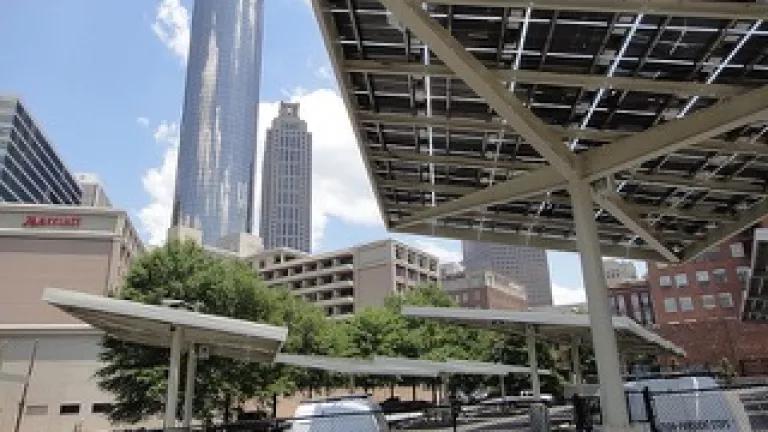
Anyone who's ever sat out on a Georgia afternoon or wandered outdoors in the bright Florida sunshine, knows the solar power potential in these two Southeastern states is enormous. Now, after a slow start, so is the headway the clean power technology is making in the Southeast's two most populous states. "In 2011, if you told me we'd be where we are today with solar," says one Georgia solar advocate, "I would have laughed."
Under a new bill signed today, Georgia will install a lot more solar power, like this array at an Atlanta hotel. Photo by John S. Quarterman
Georgia, in particular, has become a solar standout, moving from 26th nationally in new solar capacity in 2012 to 7th in 2013. The Solar Power Free-Market Financing Act of 2015, signed today (Tuesday) by Governor Deal, will finally authorize in the Peach State the kind of solar power purchase agreements that have spurred solar growth across the country, enabling home- and business owners to stake their own claim to energy independence. (PPAs allow third-party developers to install solar on a home or business, and then sell the electricity back to the user at a discounted rate, often with no upfront costs.)
In Florida, a diverse coalition that includes the Tea Party Network, the Florida Alliance for Renewable Energy, Greenpeace, and the Florida Retail Federation, has geared up to put a question on the state's November 2016 ballot that would finally make PPAs possible in the Sunshine State.
All of which means Georgia and Florida may be poised to take full advantage of solar power's many benefits: pollution-free electricity, cost-savings on energy, energy independence, easier and cost-effective compliance with the EPA's Clean Power Plan to cut carbon pollution from existing power plants, and, good jobs galore. "The rest of the country is moving forward," Susan Glickman, Florida Director of the Southern Alliance for Clean Energy, says. At long last, Georgia and Florida are likely to move with it.
Solar blossoms in the Peach State
For years, thanks to utility opposition, solar power development was stalled in Georgia. But in 2013, with the price of solar plummeting and Georgia ratepayers on the hook for cost overruns at two nuclear reactors, prominent conservatives began supporting the clean power of the sun. One was Republican Public Service Commissioner Lauren "Bubba" McDonald spearheaded a plan now called the Georgia Power Advanced Solar Initiative (ASI) that would integrate 210 megawatts of solar power into the grid. (That plan was soon expanded and will now add an additional 525 MW, enough to power 48,000 homes.) Another prominent conservative threw her weight behind solar, too: Tea Party Patriot leader Debbie Dooley. "Local conservatives have come to see solar as a free-market issue, which it is," says one local advocate. "It's a matter of property rights. Their recognition of that has done a great deal to bring solar to a more visible place in the Georgia economy." Indeed, solar businesses in the state now employ almost 3,000 and anticipate adding as many as 650 jobs this year.
Perhaps it's not surprising, then, that when Georgia State Representative Mike Dudgeon (R-Johns Creek) offered House Bill 57, to allow third-party financing of solar power systems in the state, this spring it passed both houses of the Georgia General Assembly unanimously. It will open the Georgia solar market, which has been largely driven by utility-scale development, to residential and commercial customers. That's a very good thing, says Brion Fitzpatrick, chairman of the Georgia Solar Energy Industries Association, the state chapter of the industry trade group. "This shows how working together toward a common goal can transcend political divisions and produce lasting, productive results for all of Georgia."
Sun power in the Sunshine State
When it comes to solar power potential, Florida ranks high on the nation's list--third for solar power resources. Due in large part to that, the state could feasibly generate a mind-blowing 25 times its current electric needs using clean, renewable energy. Here's another fact that gives solar a natural constituency in the Sunshine State: with its hot and humid weather, residents face electric bills that are 40 percent higher than the national average.
In a few locations in Florida, solar has made progress. In Gainesville, home to the University of Florida, the municipal utility ran the nation's first feed-in tariff for solar, between 2009 and 2014, spurring the installation of more than 18 megawatts of solar power--enough to supply more than 1,400 homes. But at the state level, the legislature and the governor have consistently given solar the cold shoulder; Florida is one of only five states in the nation that prohibits PPAs. "To call us 'underperforming' on solar is an understatement," Glickman says.
Rather than once again trying to move through the legislature, advocates are now taking a different tack. They've organized an incredibly diverse coalition of political groups, retailers, environmental organizations and local governments in an effort to put solar PPAs on the state ballot in 2016.
There are several hoops that must be jumped through for the proposal to pass. First, its language must pass muster with the state's Supreme Court. Then, by the end of 2015, advocates from Floridians for Solar Choice must collect almost one million signatures in favor of bringing the question to a vote. Finally, the initiative has to receive a full 60 percent of the vote in November 2016. Nevertheless, advocates are optimistic. Says Glickman, "People inherently understand that Florida has a significant solar resource we're allowing to go untapped."
The Southeast's solar power potential has been one of our country's greatest, underused energy resources. With Georgia and Florida advocates across the political spectrum leading the way, though, lost solar power opportunities in the Southeast may soon be the way of the past.

